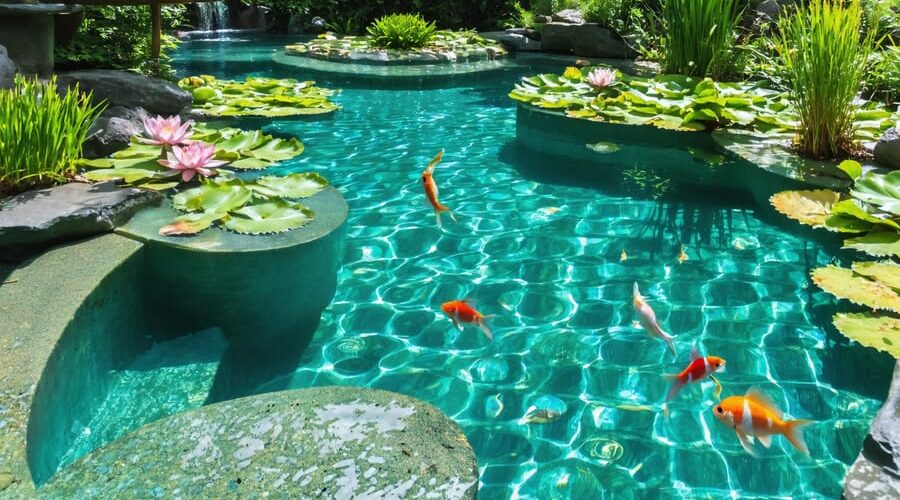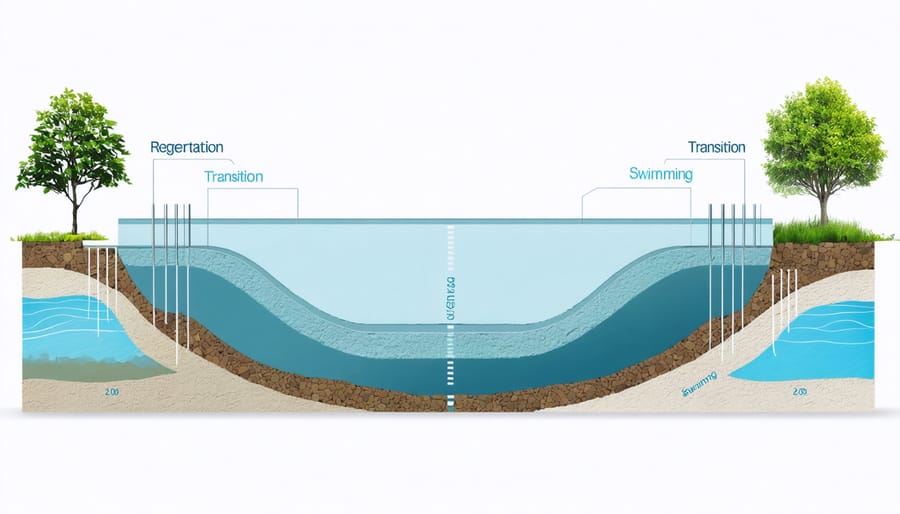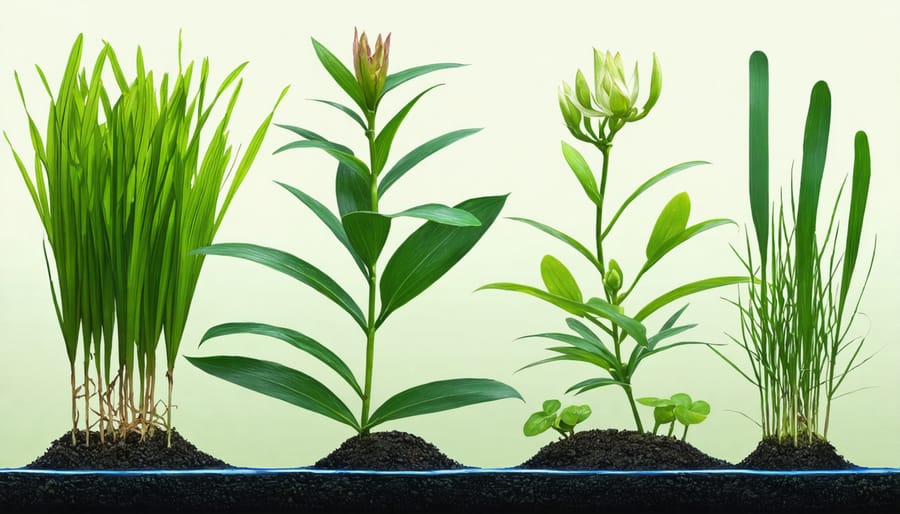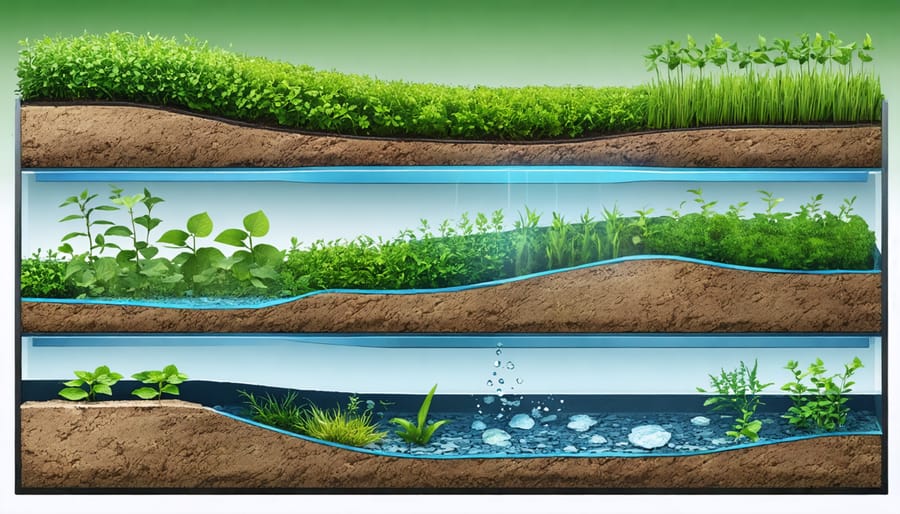
Transform Your Pond into a Crystal-Clear Natural Swimming Pool
Imagine swimming in crystal-clear water, surrounded by vibrant aquatic plants and darting fish, all without harsh chemicals. Natural filtration pools represent the perfect fusion of sustainable design and pristine swimming environments, mimicking nature’s own purification systems to create a thriving pond ecosystem. Unlike traditional chlorinated pools, these living water features use carefully selected plants, beneficial bacteria, and specialized gravel beds to naturally filter and clarify water. The result? A self-sustaining swimming paradise that’s both environmentally friendly and surprisingly low-maintenance.
Modern natural pools have evolved far beyond simple pond designs, incorporating sophisticated biological filtration zones that work seamlessly with architectural elements to create stunning backyard focal points. Whether you’re looking to build a new pool or convert an existing one, natural filtration systems offer a chemical-free alternative that’s safer for your family, gentler on the environment, and more cost-effective over time. Let’s dive into how these remarkable systems transform ordinary water into a living, breathing aquatic sanctuary.
How Natural Filtration Pools Work
The Three-Zone System
Natural filtration pools operate using a clever three-zone system that mimics nature’s own water purification process. The regeneration zone, often called the plant zone, is where most of the cleaning magic happens. Here, carefully selected aquatic plants and beneficial bacteria work together to filter out nutrients and impurities from the water. This area typically takes up about half of the pool’s total surface area.
The transition zone acts as a buffer between the regeneration and swimming areas. It contains fine gravel and smaller plants, further helping to clean the water while creating a gentle slope into the swimming zone. This middle section is crucial for maintaining water clarity and preventing cross-contamination between zones.
Finally, the swimming zone is your dedicated space for enjoying crystal-clear water. This area is typically deeper and free from plants, making it perfect for swimming. The water here constantly circulates through the other zones, ensuring it stays naturally clean and refreshing. The three zones work in harmony, creating a self-sustaining ecosystem that requires minimal maintenance and no harsh chemicals.

Beneficial Bacteria and Microorganisms
The true heroes of natural filtration pools are the beneficial bacteria and microorganisms that work tirelessly to keep your water crystal clear. These microscopic helpers break down organic matter, convert harmful compounds into harmless ones, and create a balanced ecosystem that maintains itself naturally.
Different types of bacteria play unique roles in this process. Nitrifying bacteria transform toxic ammonia from fish waste and decaying plants into nitrates that aquatic plants can use as fertilizer. Other bacteria species digest leaves, algae, and organic debris, preventing them from clouding the water.
These beneficial microorganisms colonize the filter media in your regeneration zone, creating what’s known as biofilm. This living layer acts like a natural processing plant, cleaning your water 24/7. The key to success is providing plenty of surface area for these helpful bacteria to grow, which is why many natural pools include gravel beds and specific filter materials.
To keep your bacterial workforce thriving, ensure good water circulation and avoid using chemical treatments that could harm these beneficial organisms. As your pool matures, this microscopic community becomes more efficient, creating a self-sustaining ecosystem that requires minimal maintenance.

Essential Plants for Natural Filtration
Submerged Oxygenators
Beneath the water’s surface, aquatic plants for natural filtration work tirelessly to keep your pool crystal clear. These underwater powerhouses, known as submerged oxygenators, play a crucial role in maintaining water quality. Plants like Hornwort, Elodea, and Waterweed release oxygen directly into the water while absorbing excess nutrients that could otherwise feed algae.
These plants are super easy to grow – just anchor them to the bottom of your pool or let them float freely. They create perfect hiding spots for beneficial microorganisms and provide shelter for small aquatic life. I’ve found that a good rule of thumb is to cover about 50-60% of your pool’s bottom area with these plants.
What’s really cool about submerged oxygenators is that they work 24/7, even when you can’t see them doing their job. During summer, they help keep the water temperature stable and provide a natural habitat feel. Just remember to thin them out occasionally, as they can grow quite enthusiastically when happy!
Floating Plants
Floating plants are the unsung heroes of natural filtration pools, creating a living carpet that not only looks beautiful but also works tirelessly to keep your water crystal clear. These aquatic warriors, like water lettuce and duckweed, spread their roots into the water while their leaves dance on the surface, absorbing excess nutrients that would otherwise feed unwanted algae.
The beauty of floating plants lies in their simplicity – they don’t need soil or special planting, just gentle placement on your pool’s surface. Water hyacinths, with their lovely purple blooms, are particularly effective at removing nitrogen and phosphorus, while salvinia can double in size every few days, rapidly soaking up nutrients.
For best results, aim to cover about 30-40% of your pool’s surface with floating plants. This coverage provides enough space for the plants to work their magic while leaving plenty of open water for viewing and swimming. Remember to thin them out regularly as they multiply, sharing extras with fellow pond enthusiasts or composting the excess.
Marginal Plants
Marginal plants play a crucial role in natural filtration pools by absorbing excess nutrients and providing a beautiful transition between water and land. Popular choices include iris, rushes, and cattails, which thrive in shallow water up to 6 inches deep. These plants not only filter water but also create essential habitats for beneficial insects and amphibians.
For best results, plant these water-loving species in specialized aquatic baskets filled with a mix of heavy clay soil and gravel. Space them about 12-18 inches apart along the pond’s edge or on shallow shelves. Some excellent starter plants include marsh marigolds for spring color, sweet flag for texture, and water forget-me-nots for summer blooms.
Remember to trim back dead foliage regularly and divide overgrown plants every few years to maintain their health and effectiveness. During winter, leave the dried stems standing as they continue to filter water and provide winter interest to your pond.
Setting Up Your Natural Filtration System
Planning and Layout
Creating a self-sustaining water system starts with careful planning and smart space utilization. For a natural filtration pool to function effectively, you’ll need to dedicate roughly one-third of the total area to the regeneration zone, where plants and beneficial bacteria will do their filtering magic.
The ideal layout includes three distinct areas: a swimming zone (typically 50-60% of the space), a regeneration zone (30-35%), and a transition area (10-15%). For a family-sized pool, aim for at least 50 square meters total, though larger spaces offer more flexibility and stability.
When planning your pool’s shape, consider both aesthetics and functionality. Natural, curved designs blend beautifully with the landscape, while geometric shapes can complement modern architecture. Remember to include gradually sloping sides in the regeneration zone to accommodate different plant species at varying water depths.
Sun exposure is crucial – aim for a spot that receives 6-8 hours of direct sunlight daily to support plant growth. Also, factor in access points, seating areas, and maintenance pathways around the pool’s perimeter. A gentle slope in the surrounding landscape helps manage water runoff and creates opportunities for attractive waterfall features.
Substrate Selection
Selecting the right substrate materials is crucial for your natural pool’s filtration success. The most effective setup typically uses a combination of different-sized materials, arranged in layers from coarse to fine. Start with larger stones (2-4 inches) at the bottom, which create spaces for beneficial bacteria to colonize. Add a middle layer of gravel (1/2 to 1 inch), which helps trap larger particles while maintaining good water flow.
For the top layer, use a mix of fine gravel and coarse sand (1/8 to 1/4 inch). This final layer acts as a mechanical filter, catching smaller particles while still allowing water to pass through easily. Many pool owners also include zeolite or activated carbon in their substrate mix, as these materials excel at removing impurities and controlling ammonia levels.
When choosing materials, opt for rounded river rocks rather than crushed stone, as sharp edges can compact over time and reduce water flow. Avoid limestone if you have acid-loving aquatic plants, as it can raise water pH. The total depth of your substrate layers should be between 16-24 inches, depending on your pool’s size and design. Remember to rinse all materials thoroughly before installation to remove dust and debris that could cloud your water.

Plant Installation
Planting in your natural filtration pool requires careful consideration of both aesthetics and functionality. Start by dividing your plants into three main zones: shallow marsh, deep marsh, and underwater areas. In the shallow marsh zone (0-6 inches deep), install marginal plants like rushes and iris in planting baskets filled with aquatic soil. Space them about 12-18 inches apart to allow for growth.
For the deep marsh zone (6-18 inches), choose plants like water lilies and cattails. Secure them in heavy-duty mesh baskets with aquatic soil and top with gravel to prevent soil dispersion. Remember to position taller plants toward the back of viewing areas and shorter varieties in front for visual appeal.
Submerged plants like hornwort and elodea should be weighted down or planted directly in the gravel substrate. These workhorses of filtration need plenty of room to spread, so plant them in clusters with 6-8 inches between groups.
For best results, install plants during spring or early summer when they’re actively growing. Avoid overcrowding, as plants need space to develop strong root systems and perform their filtering functions effectively.
Maintenance and Troubleshooting
Seasonal Care
Natural filtration pools require different care throughout the seasons to ensure optimal performance and beauty. In spring, focus on removing debris that accumulated during winter and trimming back any dead plant material. This is also the perfect time to add new aquatic plants, helping in maintaining natural balance as the water warms up.
Summer brings increased biological activity, requiring regular monitoring of water levels due to evaporation. Keep floating plants like water lilies trimmed to prevent overcrowding, and ensure your regeneration zone plants are thriving. Remove any algae growth promptly to maintain clear water.
As autumn approaches, install protective netting to catch falling leaves before they sink and decompose. Remove dying plant material and trim back marginal plants to prevent excess organic matter from entering the water system.
Winter care focuses on protecting the pool’s ecosystem during dormancy. If you live in a cold climate, consider using a pool heater to prevent complete freezing, which could damage the biological filtration system. Keep a small area free of ice to allow proper gas exchange, and avoid breaking ice directly on the pool surface as this can stress any overwintering fish.
Regular seasonal maintenance ensures your natural pool remains healthy and beautiful year-round, requiring just a few hours of attention each month.
Common Problems and Solutions
Even well-maintained natural filtration pools can encounter occasional issues, but most are easily resolved with the right approach. Here are the most common problems and their solutions:
Algae blooms often occur during warm weather or when nutrient levels are high. Combat this by adding more floating plants to absorb excess nutrients and ensuring your regeneration zone has adequate plant coverage. If needed, temporarily increase water circulation or add beneficial bacteria to restore balance.
Cloudy water typically indicates an imbalance in the filtration system. Check that your pump is running efficiently and clean any clogged filters. Adding more filter-feeding plants like water hyacinth can help clear the water naturally. Sometimes, patience is key as the system needs time to establish proper biological balance.
Mosquito concerns can arise in still water areas. Introduce natural predators like mosquito fish or ensure constant water movement through properly placed pumps. Adding submerged oxygenating plants also helps discourage mosquito breeding.
Unpleasant odors might develop if organic matter accumulates. Regular skimming of fallen leaves and debris prevents this issue. If odors persist, check oxygen levels and consider adding an air stone to increase circulation.
Plant die-off can occur due to improper plant selection or placement. Choose plants suitable for your climate zone and ensure each species is planted at the correct depth. Some plants may need seasonal replacement or division to maintain healthy growth.
Most issues resolve themselves as the ecosystem stabilizes, but maintaining proper plant balance and regular monitoring are key to preventing problems before they start.
Natural filtration pools offer an incredible opportunity to create a sustainable, chemical-free oasis in your backyard. By embracing nature’s own filtering processes, you’ll not only save money on maintenance but also create a thriving ecosystem that benefits local wildlife. The combination of aquatic plants, beneficial bacteria, and mechanical filtration works together seamlessly to maintain crystal-clear water while adding beauty to your outdoor space. Whether you’re starting from scratch or converting an existing pool, the journey to natural filtration is rewarding and environmentally responsible. Take the first step today by planning your natural pool system, and join the growing community of homeowners who are choosing this eco-friendly approach to water management. Your perfect swimming paradise awaits!
